As @Rocky mentioned, it looks like in your code you are confusing bits and bytes.
It might help if you think of a byte in binary:
Binary Decimal Hex
00000000 0 0x00
00000001 1 0x01
00110000 48 0x30
If you look at the binary representation, you count the bits from the right: A byte has 8 bits, so bit 7 is the left-most bit and bit 0 is the right-most bit.
The reason why hexadecimal (base-16) notation is so convenient is because it is easier to convert between binary to hex than binary to hex.
Take the binary number 00110000. If you split these up into two parts (0011) and (0000) called the high nibble (bits 7-4) and the low nibble (bits 3-0). Then you can easily convert the two nibbles into hex:
Nibble Hex Decimal
0000 0 0
0001 1 1
0010 2 2
0011 3 3
0100 4 4
0101 5 5
0110 6 6
0111 7 7
1000 8 8
1001 9 9
1010 A 10
1011 B 11
1100 C 12
1101 D 13
1110 E 14
1111 F 15
Putting the two nibbles together, you can see the relationship between hex and binary:
Binary
0011 1100
Hex
3 C
so binary 00110100 = hex 34 = dec 60
So back to your binary format:
In the request packet, you are getting the response (hex 30), so if you convert that into your bit:
Hex 30 = binary 0011 0000
You can see that bit 5 and 4 are set.
In order to dynamically set bits in a byte, you'll need to use boolean logic AND and OR. See the following for results of and and or on a single bit:
Bit Bit Result Result Result
A B AND OR XOR
0 0 0 0 0
0 1 0 1 1
1 0 0 1 1
1 1 1 1 0
You've also got the NOT operation
Bit Result NOT
0 1
1 0
With multiple bits, you just perform the operation on each bit (bit 7 to 0), for example:
01101010 (hex 6A)
AND 11100110 (hex E6)
= 01100010 (hex 62)
01101010 (hex 6A)
OR 11100110 (hex E6)
= 11101110 (hex EE)
NOT 00111001 (hex 3B)
= 11000110 (hex C6)
So with that in mind, you can use the following operations to set and clear individual bits in a byte:
If you want to ensure that bit 6 is set (1), you just have to OR it with 01000000 (hex 40)
xxxxxxxx (any value)
OR 01000000 (hex 40)
= x1xxxxxx
If you wanted to ensure that bit 6 is clear (0), you just have to AND it with NOT (hex 40), so
NOT 01000000 (hex 40)
= 10111111 (hex BF)
xxxxxxxx (any value)
AND 10111111 (hex BF)
= x0xxxxxx
To put all this into Java code, you've got the following binary operators:
- | binary OR
- & binary AND
- ~ binary NOT
So if you wanted to set a bit in a byte:
byte anyByte;
anyByte = anyByte | 0x40;
which can be shortened to
anyByte |= 0x40;
If you want to clear a bit:
anyByte &= ~0x40;
If you want to test whether a bit is set, you'd use the following:
if ((anyByte & 0x40) == 0x40) ...
If you want to test whether bit 4 and bit 1 was set, you'd do the following:
if ((anyByte & 0x12) == 0x12) ...
Why 0x12? Because hex 12 is binary 0001 0010 which "masks" bit 4 and 1.
Back to your question:
In order to send the correct command string, you just need to create the right byte array as specified in the manual, though I hope it is clearer now how to set bits in bytes:
Socket s = new Socket("192.168.1.2", 49137);
InputStream in = s.getInputStream());
// send the request
// (Note, for different requests, you'll need different, byte arrays and may
// even have different lengths (can't tell without having seen the whole manual)
byte[] st = new byte[] { 0x01, 0x30, 0x01, 0x00 };
OutputStream out = s.getOutputStream();
out.write(st);
out.flush();
// read the first header byte (bits indicate the rest of the header structure)
byte header = (byte)in.read();
// bit 1 shows whether the header represented in 2 bytes
boolean header2Byte = (header & 0x2) != 0;
// bit 2 shows whether the length is represented in 2 bytes
boolean len2Byte = (header & 0x4) != 0;
if (header2Byte) {
// need to read the extra header (discarded here)
in.read();
}
// missed off reading the command byte/s
int len = 0;
if (len2Byte) {
byte[] lenByte = new byte[2];
in.read(lenByte);
if (isLittleEndian) {
len = (lenByte[1] << 8) + lenByte[0];
} else {
len = (lenByte[0] << 8) + lenByte[1];
}
} else {
// only one byte signifies the length
len = is.read();
}
byte[] data = new byte[len];
in.read(data);
// it is unclear what format the data, has but if it is a string, and encoded as
// UTF-8, then you can use the following
String stringData = new String(data, "UTF-8");
System.out.println(stringData);
// note, try-catch-finally omitted for brevity
in.close();
out.close();
s.close();
Note, I'm not using a DataInputStream here as the way Java encodes integers may be different from how the device encodes it's integers. E.g. in Java and integer is 4 bytes and Big Endian (see also this SO article).
N.B. the << operator is the left shift operator, which shifts the bits along in a byte and the above case is used to combine two bytes into a 16-bit number. Left-shifting by 8 is equivalent to multiplying by 256.

